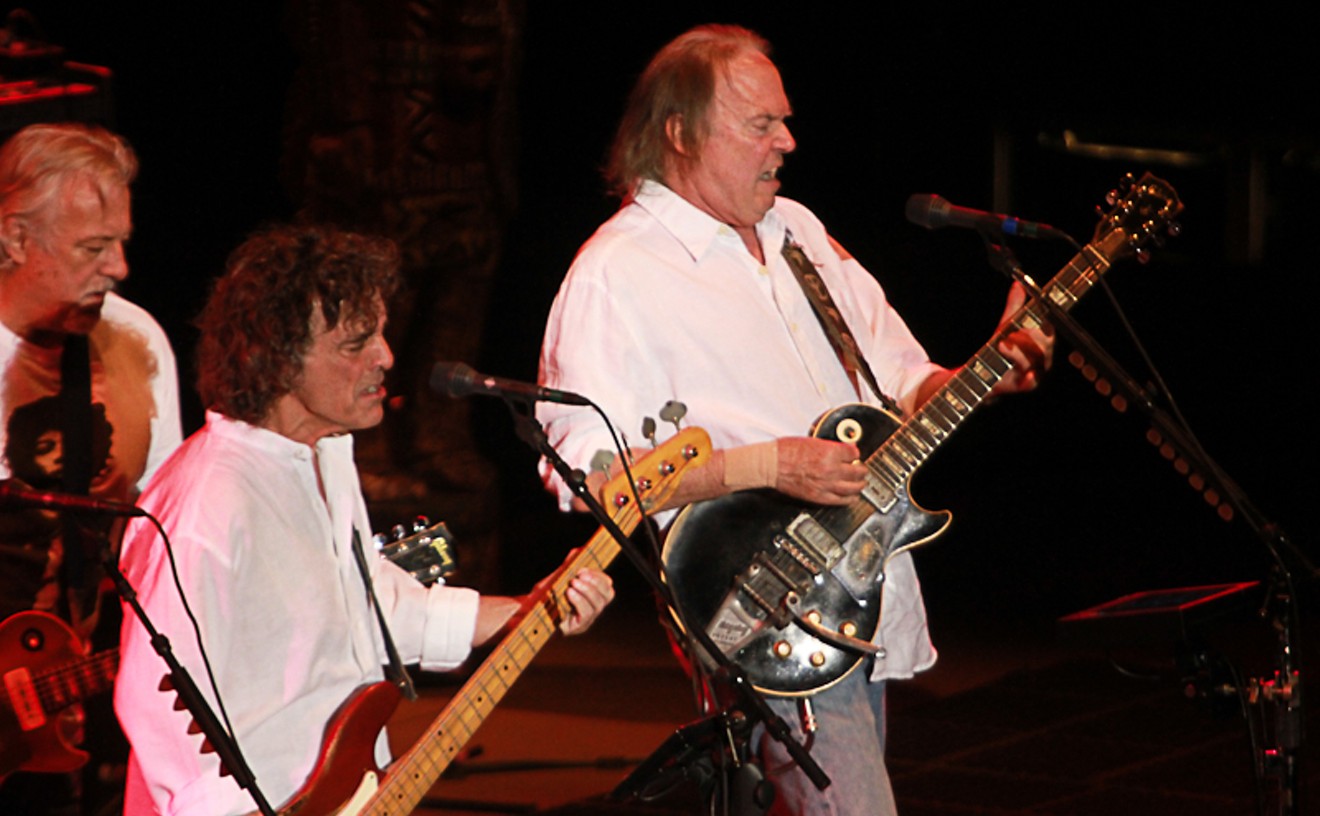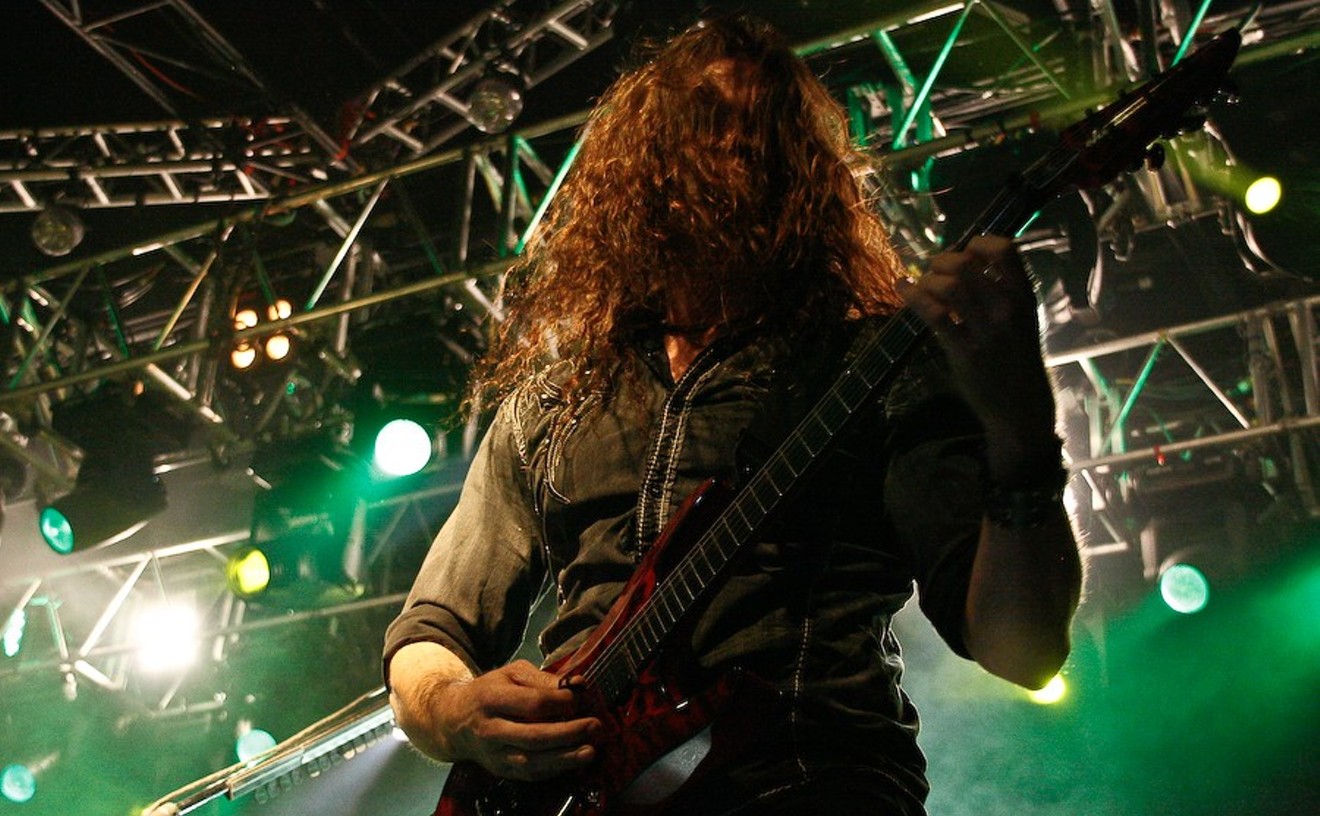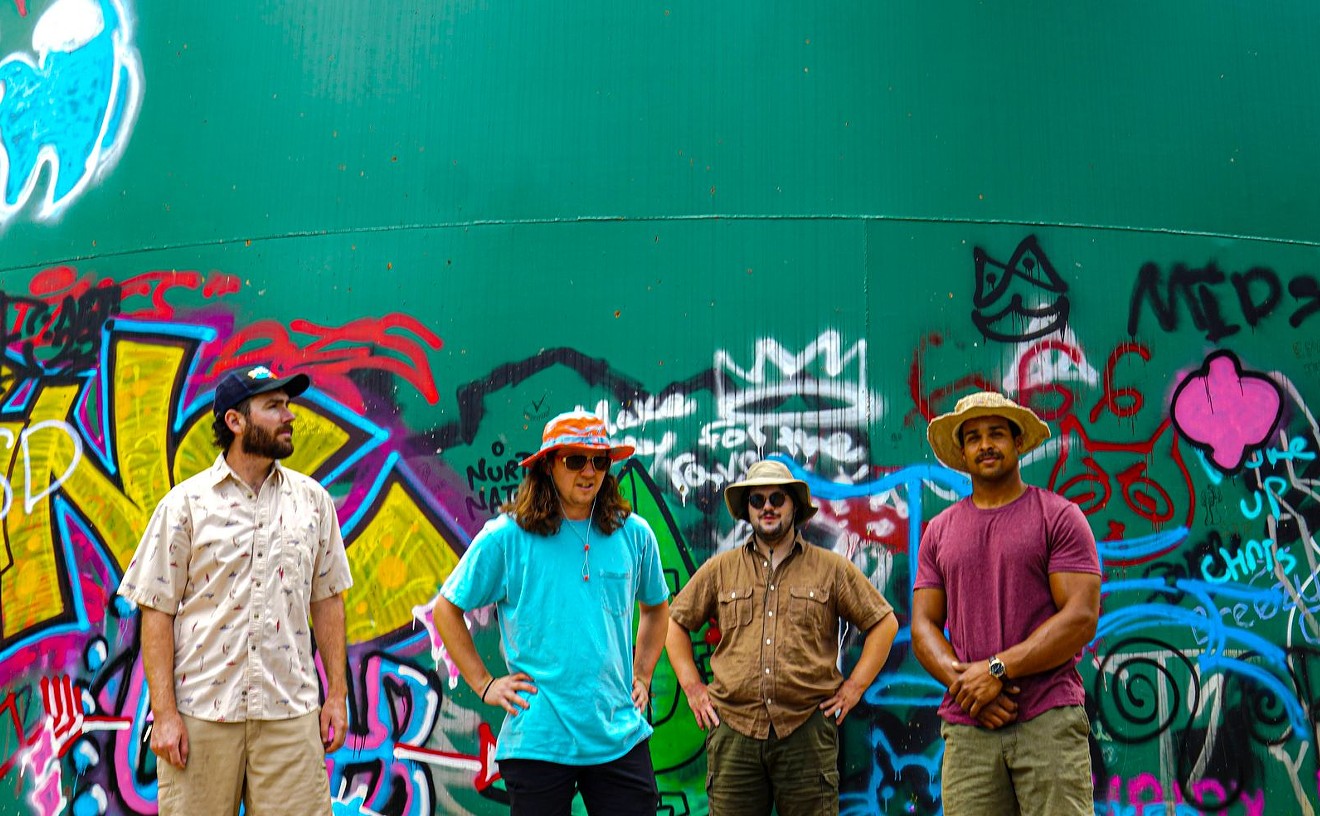Fans who followed the Dusters' rise within Boulder's music community would probably have pegged Drapes -- not Brown -- as the one who would finally make it as a country artist. Charming and talented, he'd break out. Have a hit record, or at least some songs on the radio. At times it seemed like all of those things were just around the corner. But today it's Junior Brown who's a household name; Swenson, meanwhile, has found a place among the hardworking but largely anonymous rank of artists who pursue fame -- and eventually have to admit that it's eluded them.
This weekend, Dusty Drapes and the Dusters will reunite, nearly three decades after forming the band, for a live show at the Boulder Theater; the concert follows the premiere of Sweet Lunacy, a locally produced documentary that chronicles Boulder's rock history. The Dusters are one of several acts appearing in the film, which was produced by Boulderites Leland Rucker and local television producer Don Chapman; it aims to shed light on some lesser-known elements of the city's musical past. (See Night & Day, page 37, for more about the film.) Brown -- leader of the Highway Patrol and king of the guit-steel -- won't be attending the reunion. In fact, though Swenson says the country star's entire shtick -- right down to his very name and his double-action instrument -- came about during his Duster years, Brown's never advertised his connection to Colorado.
"He wants to keep it a secret," Swenson says. "He's never acknowledged that he's played with the Dusters. He's never acknowledged that he played in Colorado. He wants everyone to think that when he was fourteen years old, he came right off the farm as Junior Brown and became this great picker."
"He wanted to be accepted in the country market," adds Teddy Carr, another ex-Duster. "If you're from Boulder, Colorado, that don't cut it if you're hanging out in Texas. You're just a Yankee."
Brown's place in the Dusters is only one chapter in the band's intriguing history. At a time when most of today's country insurgents didn't know Ernest Tubb from the kitchen sink, Swenson and his pals were creating a stir by harking back to more traditional country and preserving a cool image; the Dusters were, in essence, the region's first alt-country band. While their peers sported long hair and indulged in countrified rock, they wore crewcuts and ten-gallon hats. They embraced fiddle solos and Hank Williams. The group became a huge draw in Boulder and, at one point, seemed to be on the verge of national stardom.
"People loved them in Boulder," says Leland Rucker. "But when they tried to take it to the next level, it was a different story."
In the early '70s, Chuck Morris (now of mammoth promotional house Chuck Morris Presents/Bill Graham Presents) headed Tulagi, then the area's equivalent of the Fillmore Auditorium in San Francisco. He says the Dusters were one of the biggest homegrown acts of the time, one with big national potential. "They were doing really interesting stuff," Morris says. "The reason they didn't happen is because they were about fifteen years ahead of their time."
Yet even though the music made by Dusty Drapes and the Dusters was often inspired, the band's formation had as much to do with commercial concerns as it did with artistic ones. Swenson, a Minnesota native, came to Denver in 1971 when a friend, Danny Holien, landed a record deal with Denver's now-defunct Tumbleweed Records. Swenson played bass on Holien's debut and alongside Joe Walsh and Todd Rundgren on other Tumbleweed recordings for Michael Stanley, Rob Kunkel and Dewey Terry (of Don & Dewey fame). When Tumbleweed folded, Swenson joined a Boulder country-rock act called Sixty Million Buffaloes and started pursuing a record deal. Disgusted with that fruitless pursuit, he came up with a plan for landing steady gigs and income. "I told the guys, 'I've got a great idea. Let's cut our hair, dress like cowboys and play country music in the cowboy bars,'" he says. "I was tired of chasing the carrot. I wanted to have some fun."
In 1972, with the help of Don Debacker, Dan McCorson and others, Dusty Drapes and the Dusters were born. They quickly began drawing large crowds hungry for truck-drivin' anthems and a cornpone stage show. "The college kids really caught on to us," recalls Swenson. "Here was this band that looked like a bunch of straight cowboys, singing Johnny Cash's 'Cocaine Blues' and 'Folsom Prison' and yukking it up all tongue in cheek. We looked straight, but we were doing all these songs about drugs and stuff. The kids were like, 'These guys are hip.'"
"The band was always kind of a spectacle because of our appearance," says Carr, "and there was a huge scene that followed it around. The band was stocked with well-educated jazz players that played a lot of hot arrangements. There was humor to it, too, and it appealed to a lot of people from different walks of life."
In addition to popularity, the members of the Dusters enjoyed opportunities that they hadn't had as rock musicians -- including an offer for a recording contract.
"We started our band to get away from trying to get a record deal," Swenson recalls. "By doing that, the record companies came and knocked on our door." The group signed with Columbia Records and cut a disc in Denver. But when it came time for the record's release, Columbia got cold feet, in part because the label didn't seem know what to do with it. Carr says Columbia's decision to enlist producer Ken Mansfield, who had engineered discs for Waylon Jennings and Jessi Colter, was one of the problems. "He wanted us to have that boomp-boomp-boomp thing going on all the time," Carr says, "and we were a swing band." Swenson says Columbia was also daunted by a similar West Coast outfit -- Asleep at the Wheel -- that was about to release its debut. "It must have done okay," Swenson says, "because it led to quite a few others."
When the disc was canned, it crushed the group's spirits and led to personnel shifts during the years that followed. But the Dusters held on to their local base and played around the West, often opening for acts like Minnie Pearl, Merle Haggard, Willie Nelson and others. Brown joined the fray after an encounter that seems almost pulled from a rock-and-roll fantasy movie: The Dusters picked him up as a hitchhiker along a New Mexico highway; Carr, who had played bars in the state, recognized him as Jamison "JB" Brown, a rock musician. Brown rode with the boys all the way to Boulder and expressed an interest in filling the vacant guitarist slot. Swenson offered him the position, with a caveat. "I told him, 'You're gonna have to cut your hair, shave your beard and cowboy up.'" (According to Swenson, the clean-cut image served a dual purpose: "We could travel around the country and not get hassled.")
Brown agreed and soon morphed into a country player -- as many other rock players seemed willing to do in order to join the group. "A lot of guys wanted to be in that band," Carr says. "You'd see 'em cut their hair to come out for auditions. Then they wouldn't get hired and they'd have to go back out in public like that."
Brown fit in nicely, staying with the group for about four years. A sample of his stint in the Dusters is chronicled on a live compilation of local artists that was recorded at the Alferd Packer Grill on the University of Colorado campus in 1979. (The school produced a small number of the records that are now coveted local collectibles.) But for Swenson and Carr, the recording of Brown's impressive baritone voice and steely guitar playing serves as a bittersweet reminder of the past. Swenson says his main beef with Brown is that he's concocted an image that's more myth than fact. "The point I want to make is that he got his whole image from the Dusters," Swenson says. Carr says he was Brown's C&W mentor, turning the young player on to the sounds of Tubb, Ray Price and others while schooling him on the country-gent image.
Swenson also takes credit for Brown's famous moniker. On a trip to Texas soon after Brown had joined the group, Swenson says Brown spent the majority of the trip complaining. "Finally," Swenson recalls, "I said to him, 'I've got a good name for you. Let's call you Junior Brown.' He said, 'I don't know, I don't like that.' But I told him, 'Yeah, it's cool. It's country, you know, like Junior Samples.' [But] it wasn't because it was a cool country name. It was because he was a big baby."
(Brown was unavailable to discuss the Dusters' claims. His wife and manager, Tanya Rae Brown, acknowledged to a publicist that he had played in Boulder years ago but would not elaborate.)
Brown left the Dusters in 1979, and the group continued for a few more years, cutting a self-produced record in 1981. But its demise came about shortly after. Swenson's health had declined; at one pint, he was near death. In 1984, after a chronic case of laryngitis, Swenson looked in the mirror, "and I noticed I had two Adam's apples." Doctors diagnosed him with thyroid cancer and removed an encapsulated, malignant tumor from his throat. "It was a wake-up call for me," he says, "I hadn't been living the cleanest life. I spent years in the candy store of Boulder. You'd finish a gig, and there was always somebody offering you something. One day you wake up and you're an addict. I looked around, and all my friends were dealers."
After his surgery, Swenson returned to Minnesota, where he got sober and slowly returned to the music community. Now the leader of Cocktail Stevie and the Tablerockers, a roots-rock band that plays casinos, fairs and conventions in the Midwest, he's served as a bandleader for a number of '50s and '60s rock acts, including Bobby Vee, and continues to back vintage artists on tours in the States and in Europe. He also books shows in casinos and music rooms around the region. He's remarried ("My wife, she's my rock," Swenson says of his wife, Cindy) and remains cancer-free today.
"I'm living the American dream," Swenson says. "I'm 52 years old. I've been a bandleader ever since I was fourteen. All my life, I've made a living doing what I wanted to do."
But he can't help being bothered by the way things shook out for his beloved Dusters.
"It was a great time back then," he says, "and there was great music going on. We were really doing stuff that was ahead of its time -- maybe too far ahead of its time.
"When the album wasn't released," he adds, "it shot us dead in the water. We had nothing to show for our efforts. It was heartbreaking. I spent probably the last 25 years trying to forget about it, because the things I remembered were bad."
Some of that is changing now. Last fall, a friend of Swenson's discovered a reel-to-reel copy of the Dusters' unreleased Columbia record; he duped the tape to disc and shipped several copies to Swenson. "When I opened them up, I nearly fell on the floor," Swenson says. "It's such a profound deal for me. Here, after 25 years of not having any product, I've got product in my hands."
Swenson has reproduced a number of the discs to pass out to old fans and friends -- and to sell to newcomers at the Dusters show this weekend. What he's really looking forward to is getting back on stage and reliving a few glory days. The good times, he adds, will sound better this time around.
"Two of our biggest offenders as far as drinking goes are now AA guys," Swenson says. "It'll be kind of funny looking around on stage and seeing everybody sober. We always had the fun meter on ten, and it'll still be up there. Maybe this time we'll be able to actually see it."










